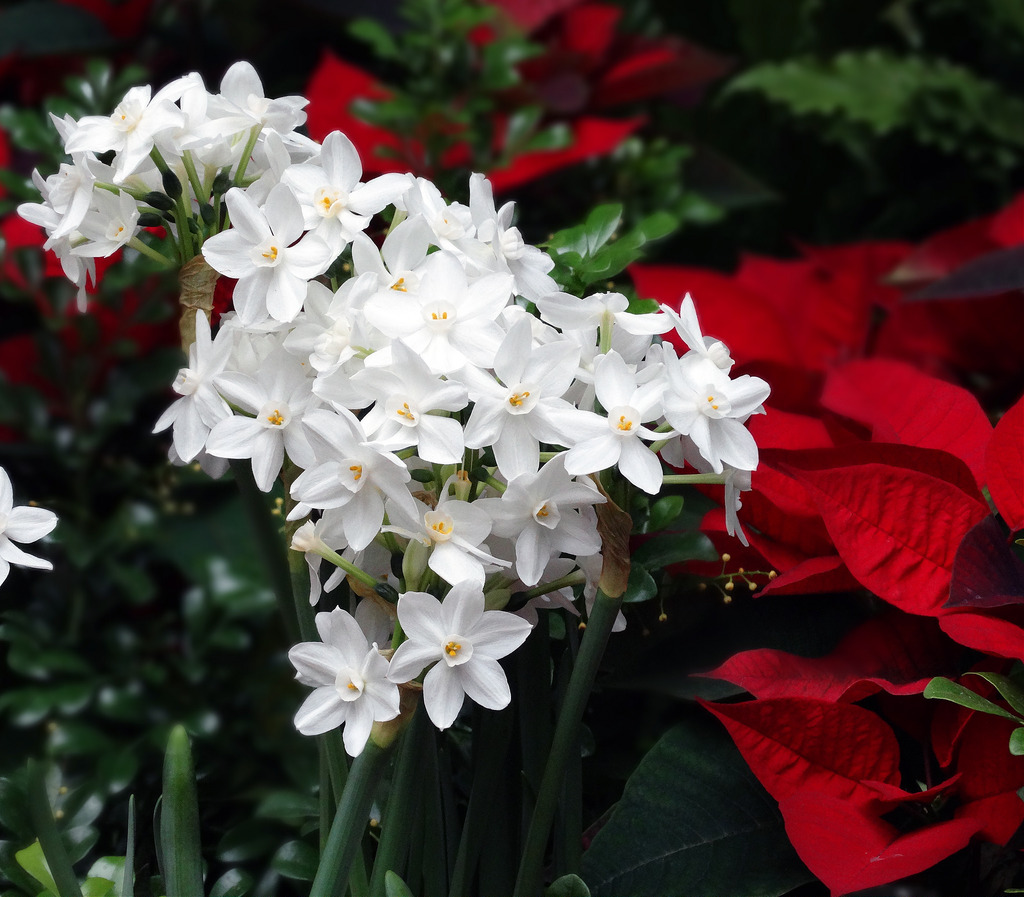WHY FORCE?
Because newly purchased bulbs already contain the embryonic bloom for the following season, you can - with a bit of extra effort - manipulate conditions to induce flowering before the bulb's normal outdoor blooming season. This process is popularly know as "forcing."
Forcing takes advantage of the fact that bulbs have certain minimum requirements for each stage prior to bloom. Because outdoor climate slows development, bulbs in the ground usually take more time than is minimally necessary in the pre-bloom stages. But under a forcing regime, you can control conditions so each stage is completed as quickly as possible.
For the most satisfying results, buy large top-quality bulbs. Forcing draws heavily upon a bulb's food reserves, so those that have the greatest amount of stored energy will perform the best.
TIMETABLE FOR BLOOMING
You can calculate the time to plant in order to achieve blossoms at the desired date. Most bulbs planted in potting soil will bloom 12 to 15 weeks after planting. On the other hand, narcissus grown in pebbles and water or in soil take just 6 weeks to flower.
With the exception of Amaryllis, forced bulbs cannot be forced for a second season. After blooming is over, set bulbs out in the garden; in a year or two, they will build themselves up enough to flower at the normal time.
3 BASIC METHODS
The method of forcing you use depends in part on the type of bulb. You can "plant" in potting soil, in a tray of pebbles and water, or in water alone. The following are descriptions of each method.
1. SOIL
This method is especially well suited for tulips, hyacinth, daffodils, grape hyacinth, Dutch iris, scilla and freesia.
Using potting soil, fill your pot to within 2" of the top. Set bulbs close together an equal distance apart with pointed ends up. Add additional soil to partially cover the bulbs. Soak the entire pot thoroughly with water.
Place the container in a cool, dark place for a period of 12 weeks. During this period, the soil should be kept moist and the bulbs kept cool, with temperatures below 50°F at all times. A cool cellar or unheated garage are very good locations.
After 12 weeks the root system should be well established and 1-2" shoots should be appearing above the soil. The pot is now ready to be moved indoors to a well-lighted, fairly cool spot (55°F) for 2-3 weeks. The pale shoots will quickly turn dark green and buds will appear. When buds barely show color, move to a warm spot (72-75°F) with plenty of light (not full sun) to finish the bloom.
Narcissus planted in pebbles.
2. NARCISSUS ON PEBBLES IN WATER
The autumn and winter-blooming Narcissus tazetta varieties do not need a prolonged cool, dark period for root growth before they send up leaves, so you can easily force them indoor in an entirely soil-free medium. Most popular are the Chinese sacred lily (N. tazetta "Orientalis") and the varieties 'Paper White' and 'Grand Soleil d'Or.' For 'Paper White', the interval between starting and blooming is about 6 weeks. If your first planting is made in October, then plant at 2 week intervals until December. You can have flowering Narcissus indoor over a 2 month period. For a beautiful Thanksgiving bloom of 'Paper Whites', plant now. For a Christmas bloom we recommend planting around Veteran's Day or any time during the second week of November.
Choose a container without a drainage hole and about 3-5" deep. Fill the bottom 2/3 with clean, smooth pebbles such as pea gravel or aquarium rock. Place bulbs in gravel so that the base is slightly covered. Fill with water to the top of the gravel and add water as needed to maintain water level at, or just below, the base of the bulbs.
Pots can be started in a cool, well lit area until buds appear, then moved as desired. Caution; too much shade or darkness will cause the foliage and stems to stretch and become floppy. Likewise, too much warmth will force top growth at the expense of roots.
Handblown Bulb Forcing Glass Vase via Elizabeth's Embellishments
3. HYACINTH & CROCUS IN BULB GLASSES
Both hyacinths and crocuses can be grown in water alone if you use the special glass vessels made for this purpose. These container look something like exaggerated egg cups: the bulb rests securely in the smaller upper section, while roots grow into the larger, water-filled lower part.
To "plant" the glasses, fill them with just enough water to touch the bulb's base, then add a small piece of activated charcoal to help prevent the growth of algae. Place the planted glasses in a dark, cool place (around 55°F) until the roots are well developed and top growth has begun; add more water as necessary during this time to keep the level just beneath the bulb's base. When growth is underway, transfer glasses to a room with plenty of light and relatively cool temperatures (65 - 68°F). You can expect blossoms in 14-16 weeks.
We have an abundance of bulbs to choose from located near our outside shop. Stop in and let us help you get your bulb plantings, inside or out, started today!



